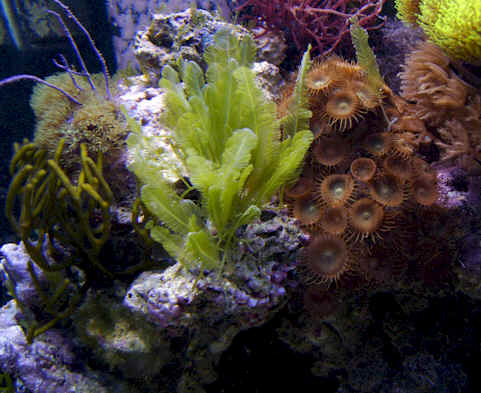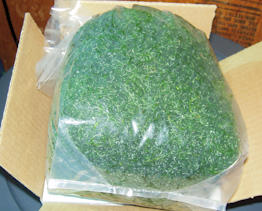|
Finding
a reliable source for the purchase of marine plants can be
challenging at times. Most varieties are only offered seasonally
as they are collected from the wild. The good news is that today the
amount of online retailers, as well as
pet stores that provide macro algae and sea grass
for sale, are increasing annually due to high demand for new and
interesting specimens. Some slow-growing and rare species can be very
difficult to obtain and are best acquired through a fellow
hobbyist or local aquarium club. Just like corals, most cultured
macro algae is hardier and more tolerant of aquarium conditions as
it has been acclimated to survive under less than optimal
conditions.
 The
major cultured varieties are Chaetomorpa, Gracilaria, Ulva,
Halymenia, Hypnea and
some species of Caulerpa. The best place to purchase marine plants
is from your local pet store or hobbyist as these specimens can be
examined for health and possible undesirable hitchhikers. As
the popularity of the refugium and planted aquariums increases,
many pet store owners are realizing the benefits and profitability
of carrying different varieties of colorful macro algae for their
customers. The
major cultured varieties are Chaetomorpa, Gracilaria, Ulva,
Halymenia, Hypnea and
some species of Caulerpa. The best place to purchase marine plants
is from your local pet store or hobbyist as these specimens can be
examined for health and possible undesirable hitchhikers. As
the popularity of the refugium and planted aquariums increases,
many pet store owners are realizing the benefits and profitability
of carrying different varieties of colorful macro algae for their
customers.
Most macro
algae species that don't ship well are very resilient and can be nurtured back to health
within a few days if given the proper environment. Sea grass
specimens however, must be in optimal health with fully intact root
systems to survive. Look for specimens that have new growth at the
tips or roots and appear healthy and green. Most varieties of red
algae will not tolerate any drying of their fronds and should
always be submerged or transported completely wet. Healthy
specimens of Caulerpa will have new growth at the tips and will
not have numerous clear and yellow fronds which is an indication of
poor health.
When
purchasing specimens through the mail, be sure to inquire how the
plants will be shipped, as packaging and transport methods vary
greatly between different vendors. Most macro algae, sea grass and
mangroves ship fairly well and can even be sent for durations of
24 hours or more through the mail with good success. The important
thing to consider when purchasing product online or through a
catalog is the quality of the specimen when collected and the
facility in which it was stored prior to shipping. Many
wholesale distributors just ship algae that has been recently
collected and hasn't been acclimated to aquarium conditions. Choose vendors that have a solid reputation and
readily share information on acclimation and care.
Simple
inspection of the plants prior to introducing them into an
aquarium or refugium is necessary. Pruning of dead or discolored
tissue and removing any undesirable hitchhikers will greatly aid
in the acclimation of new specimens. It is also recommended that
macro algae and sea grass specimens be quarantined, especially if
adding to a system with seahorses, pipefish, etc, that are more
susceptible to disease and infection. Depending on the species, it
is beneficial to drip-acclimate macro algae to its new environment
as any sudden change in water quality can often induce a sexual
event causing the plant to sporulate and die. Caulerpa
species will not
tolerate sudden changes in water temp, ph or specific gravity and
have built in indicators to send out spores when conditions change
suddenly. Identification
can sometimes be difficult between different species of macro
algae as many are very similar in composition. Just like with
marine tropical fish, many species are sold incorrectly or
mislabeled at the pet store. While this is not normally a major
issue, it helps to properly identify the species in order to care
for it.  Keep
in mind that some deeper water species will not tolerate poor
water quality, such as the beautiful Botyocladia and many of the
algae from the Pacific. When introducing macro algae and especially sea grass specimens to
a new aquarium, it is generally a good idea not to overstock as
they need time to adjust and get established. One exception would
be a sea grass dominated system. Most sea grass grows very slowly;
in fact, Turtle Grass can take a year or more in the wild to
re-colonize an area after its roots have been disturbed. For this
reason, it is a good idea to provide fast growing specimens, such as
Caulerpa, to help in the maturing of the aquarium so
that nuisance algae does not take over, while root systems are
developing. Even in the most well equipped aquariums, some species
will do better than others and some unfortunately will simply
refuse to grow. With this in mind, it is worthwhile choosing a
variety of species to see which do better in their new
environment. Keep
in mind that some deeper water species will not tolerate poor
water quality, such as the beautiful Botyocladia and many of the
algae from the Pacific. When introducing macro algae and especially sea grass specimens to
a new aquarium, it is generally a good idea not to overstock as
they need time to adjust and get established. One exception would
be a sea grass dominated system. Most sea grass grows very slowly;
in fact, Turtle Grass can take a year or more in the wild to
re-colonize an area after its roots have been disturbed. For this
reason, it is a good idea to provide fast growing specimens, such as
Caulerpa, to help in the maturing of the aquarium so
that nuisance algae does not take over, while root systems are
developing. Even in the most well equipped aquariums, some species
will do better than others and some unfortunately will simply
refuse to grow. With this in mind, it is worthwhile choosing a
variety of species to see which do better in their new
environment.
|